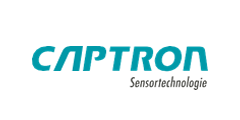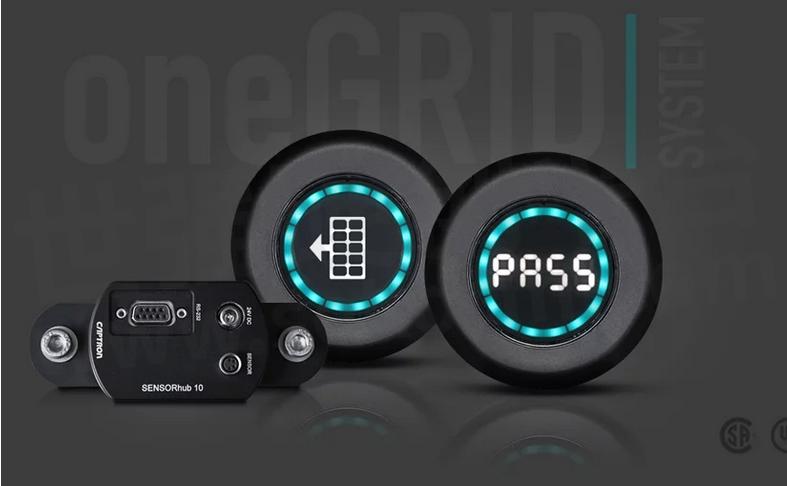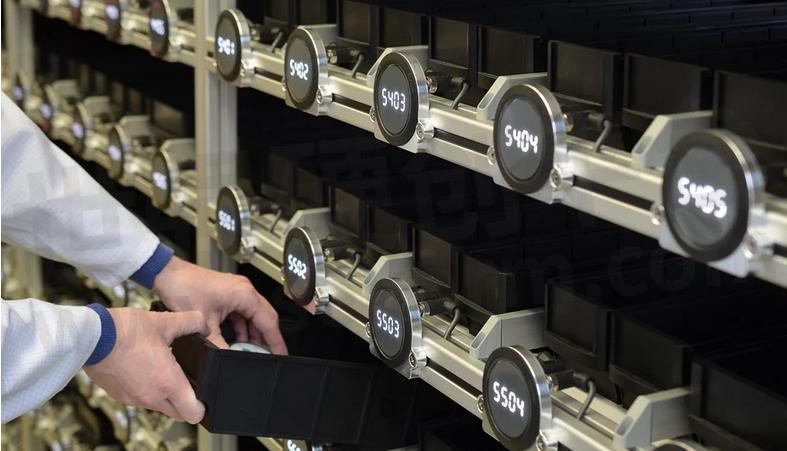CAPTRON oneGRID Pick-by-light System Makes Picking Process Efficient

Current technologies at a glance
In 2019, sales in the B2C e-commerce market in Germany amounted to around 59.2* billion euros - and the trend is rising. The logistics process behind every order seems to be quite straightforward: determine the location of the goods, take the correct amount from stock, and pack the customer order.
Yes, the principle is simple, but there are several methods and technologies in order picking: starting with paper "pick-by-paper" and pick-by-barcodes to pick-by-voice, pick-by-vision, and pick-by-light. The choice of system can depend on several parameters, such as the size of the warehouse, the size of the order, and the volume and variety of products in the warehouse.
The systems in detail
The most rudimentary method is pick-by-paper, in which printed order slips with pick lists are used, with which the order picker picks the individual products from their respective locations. This may be great for small businesses with small order sizes, but it is difficult to scale, can be slow, error-prone, and most importantly, it does not provide real-time management information.
Pick-by-barcode is a further development of this system. In conjunction with a warehouse management system (WMS), the order picker uses a barcode scanner to locate and identify the product or products. As soon as the product is picked, the data can be sent back to the WMS so that the inventory information is automatically updated. Pick-by-barcode reduces picking times and error rates compared to pick-by-paper.

With the pick-by-voice procedure, the order picker receives his instructions via a headset, can move freely in the warehouse, and has his hands free. With the help of voice recognition, the order picker's confirmation is reported back to the WMS via the microphone. The main drawback of this system is an increased potential for errors, impairments from ambient noise, and the need for reliable radio coverage in the warehouse.
Another hands-free solution is pick-by-vision. Here the order picker wears data glasses that are connected to the WMS. This can significantly increase productivity and reduce training time for order pickers. Images and text on the screen guide the picker to achieve better accuracy and reduce the potential for picking errors. The order picker confirms the picking process with a button or a gesture over the glasses. Since the available area in the eyewear optics is usually very small, the error rate is usually not reduced in comparison to the aforementioned methods. The short battery life, the heavy weight of the glasses on one side, and the technical vulnerability unfortunately limit the advantages of this system.
The pick-by-light method also works without paper. The system guides the order picker step-by-step through the order picking process with light signals and a status display. The status display shows which and how many products are to be taken from the shelf. The order picker acknowledges the picking process by pressing a button, which updates the WMS. Errors are almost excluded due to the clear displays.
Pick-by-light systems are paperless, improve productivity, increase accuracy, and enable real-time analysis (KPIs). Using this procedure the familiarization time is also short, as the procedure can be learned very intuitively. Above all, productivity can be increased by up to 50% compared to conventional order picking, as the light signals help the order pickers quickly find the right items on the picking list. The result is higher productivity, optimized route planning, and a significant reduction in travel times in the warehouse.
Costs in the event of errors
Picking errors or inaccuracies can be expensive, as every logistician knows. The processing of returns, the re-dispatch, the additional effort in customer service: a fault in the warehouse quickly causes a three-digit amount to be corrected, affects the product margin, the profit, and the reputation of the company.
The failure of a system also causes high costs very quickly. To date, this aspect has received little consideration in the planning of logistics processes, since established systems have downtimes and this is accepted in the market. Defective mechanical buttons, time-consuming restarts in the event of software problems, failure of data glasses or barcode scanners: all of these lead to additional costs.
Taking long-term costs into account
With the pick-by-light solution from CAPTRON, up to 80 storage locations per controller can be operated simultaneously. The world's first capacitive pick-by-light system “oneGRID” makes the picking process efficient, reliable, and intuitive. It ensures that the operator selects the correct items and picks them into the correct container. Thanks to oneGRID, the processing time per order is shortened, and the system is almost indestructible and fail-safe.

A so-called Pick-Acknowledge Unit from oneGRID can easily be installed on the order picking trolley as well as on shelves. A single pick-acknowledge unit can manage up to four shelves at the same time.
Additional functions are possible, for example: if the order picker acknowledges removal or storage on the touch surface with the touch function, the status display shows how many articles are or remain on the shelf.
This enables a KANBAN connection that shows all stocks in real-time. By using pick-by-light, a whole range of other KPIs can be measured and even displayed in the warehouse. You can calculate and improve utilization, picking performance and productivity to the minute. Ultimately, the following applies: the faster and smoother the process, the more satisfied the recipient is.

- +1 Like
- Add to Favorites
Recommend
- CAPTRON Solutions causes a stir at LogiMAT 2024
- ISAC Mobile Order Picking System from CAPTRON Solutions Wins the Six Challenge 2024
- Certified Hygienic Design with CAPTRON CANEO Series10 Capacitive Switches Made Food and Pharmaceutical Production Easy
- CAPTRON Hygienic Sensors and Signaling Lights for Cleanrooms and Cleanroom Systems Achieve Optimal Cleaning and Meet Stringent Safety and Germ Reduction Requirements
- Machine Processes Quality Assurance with Captron Fork Light Sensors and Laser Measurement Technology
- Capacitive Sensor Switches Will Meet Challenges from Future Tightening Hygienic Standards in Food Industry
- Keysight PathWave System Design 2023 Software Accelerates RF System Design and Digital Mission Engineering Workflows for 5G Non-Terrestrial Networks
- Introducing Smart Wakeup Solution for Low Power Capacitive Touch Sensing Application
This document is provided by Sekorm Platform for VIP exclusive service. The copyright is owned by Sekorm. Without authorization, any medias, websites or individual are not allowed to reprint. When authorizing the reprint, the link of www.sekorm.com must be indicated.
























































































































































































































































































































































































































































































































































































































































































































































































































































































